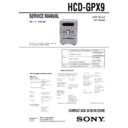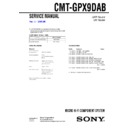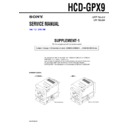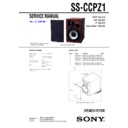Read Sony CMT-GPX9DAB / HCD-GPX9 Service Manual online
SERVICE MANUAL
COMPACT DISC DECK RECEIVER
AEP Model
UK Model
HCD-GPX9
Ver. 1.2 2005.08
SPECIFICATIONS
9-879-468-03
2005H05-1
© 2005.08
© 2005.08
Sony Corporation
Personal Audio Group
Published by Sony Engineering Corporation
Published by Sony Engineering Corporation
– Continued on next page –
HCD-GPX9 is the amplifier, CD player, tape deck
and tuner section in CMT-GPX9DAB.
and tuner section in CMT-GPX9DAB.
Model Name Using Similar Mechanism
HCD-GPX5
CDM80B-K6BD80A
CD Mechanism Type
or
CD
CDM80B-K6BD80AA
Section
BU-K6BD80A
Base Unit Name
or
BU-K6BD80AA
Optical Pick-up Block Name
KSM-213DCP
Tape deck
Model Name Using Similar Mechanism
HCD-GPX5
Section
Tape Transport Mechanism Type
CMAL1Z234A
AUDIO POWER SPECIFICATIONS
Main unit
Amplifier section
DIN power output (rated): 30 + 30 W
(6 ohms at 1 kHz, DIN)
Continuous RMS power output (reference):
35 + 35 W
(6 ohms at 1 kHz, 10%
THD)
(6 ohms at 1 kHz, 10%
THD)
Music power output (reference):
60 + 60 W
Inputs
AUDIO IN:
AUDIO IN:
Sensitivity 250 mV,
impedance 47 kilohms
impedance 47 kilohms
Outputs
PHONES:
PHONES:
Accepts headphones with
an impedance of 8 ohms or
more
an impedance of 8 ohms or
more
SPEAKER:
Accepts impedance of 6 to
16 ohms.
16 ohms.
CD player section
Laser Diode Properties
Emission Duration:
Continuous
Laser Output*:
Less than 44.6 µW
Continuous
Laser Output*:
Less than 44.6 µW
µ
* This output is the value measurement at a distance of
200 mm from the objective lens surface on the
Optical Pick-up Block with 7 mm operture.
Optical Pick-up Block with 7 mm operture.
Frequency response
20 Hz – 20 kHz
Wavelength
780 – 790 nm
Aerial terminal
75
Ω, F female
FM stereo, FM/AM superheterodyne tuner
FM tuner section
Tuning range
87.5 – 108.0 MHz
Aerial
FM lead aerial
Aerial terminals
75 ohms unbalanced
Intermediate frequency
10.7 MHz
AM tuner section
Tuning range
531 – 1,602 kHz
(with the tuning interval
set at 9 kHz)
set at 9 kHz)
Aerial
AM loop aerial, external
aerial terminal
aerial terminal
Intermediate frequency
450 kHz
Tape deck section
Recording system
4-track 2-channel, stereo
Frequency response
50 – 13,000 Hz (±3 dB),
using Sony TYPE I
cassettes
using Sony TYPE I
cassettes
Tuner section
DAB tuner section
Frequency range
Band-III:
Band-III:
174.928 (5A) –
239.200 (13F) MHz
239.200 (13F) MHz
L-Band:
1452.960 MHz (L1) –
1490.624 MHz (L23)
(L-Band is not available
for the UK model.)
1490.624 MHz (L23)
(L-Band is not available
for the UK model.)
* For details, see “DAB frequency table” below.
2
HCD-GPX9
Notes on chip component replacement
•
Never reuse a disconnected chip component.
•
Notice that the minus side of a tantalum capacitor may be
damaged by heat.r may be damaged by heat.
Flexible Circuit Board Repairing
•
Keep the temperature of the soldering iron around 270
∞
C
during repairing.
•
Do not touch the soldering iron on the same conductor of the
circuit board (within 3 times).
•
Be careful not to apply force on the conductor when soldering
or unsoldering.
This appliance is classified as
a CLASS 1 LASER product.
The CLASS 1 LASER
PRODUCT MARKING is
located on the rear exterior.
a CLASS 1 LASER product.
The CLASS 1 LASER
PRODUCT MARKING is
located on the rear exterior.
CAUTION
Use of controls or adjustments or performance of procedures
other than those specified herein may result in hazardous radiation
exposure.
other than those specified herein may result in hazardous radiation
exposure.
SAFETY-RELATED COMPONENT WARNING!!
COMPONENTS IDENTIFIED BY MARK
0
OR DOTTED LINE
WITH MARK
0
ON THE SCHEMATIC DIAGRAMS AND IN
THE PARTS LIST ARE CRITICAL TO SAFE OPERATION.
REPLACE THESE COMPONENTS WITH SONY PARTS WHOSE
PART NUMBERS APPEAR AS SHOWN IN THIS MANUAL OR
IN SUPPLEMENTS PUBLISHED BY SONY.
REPLACE THESE COMPONENTS WITH SONY PARTS WHOSE
PART NUMBERS APPEAR AS SHOWN IN THIS MANUAL OR
IN SUPPLEMENTS PUBLISHED BY SONY.
L-Band
Notes
• L-Band is not available for the UK model.
• Frequencies are displayed to two places of decimals
on this system.
Frequency
Label
1452.960 MHz
L1
1454.672 MHz
L2
1456.384 MHz
L3
1458.096 MHz
L4
1459.808 MHz
L5
1461.520 MHz
L6
1463.232 MHz
L7
1464.944 MHz
L8
1466.656 MHz
L9
1468.368 MHz
L10
1470.080 MHz
L11
1471.792 MHz
L12
1473.504 MHz
L13
1475.216 MHz
L14
1476.928 MHz
L15
1478.640 MHz
L16
1480.352 MHz
L17
1482.064 MHz
L18
1483.776 MHz
L19
1485.488 MHz
L20
1487.200 MHz
L21
1488.912 MHz
L22
1490.624 MHz
L23
Power consumption
85 W
0.25 W (in Power Saving
Mode)
0.25 W (in Power Saving
Mode)
Dimensions (w/h/d)
Approx. 181.5 × 261.5 ×
357.5 mm incl. projecting
parts and controls
357.5 mm incl. projecting
parts and controls
Mass
Approx. 5.8 kg
General
Power requirements
230 V AC, 50/60 Hz
Design and specifications are subject to change
without notice.
without notice.
DAB frequency table
Band-III
Note
Frequencies are displayed to two places of decimals on
this system.
this system.
Frequency
Label
Frequency
Label
174.928 MHz
5A
209.936 MHz
10A
176.640 MHz
5B
211.648 MHz
10B
178.352 MHz
5C
213.360 MHz
10C
180.064 MHz
5D
215.072 MHz
10D
181.936 MHz
6A
216.928 MHz
11A
183.648 MHz
6B
218.640 MHz
11B
185.360 MHz
6C
220.352 MHz
11C
187.072 MHz
6D
222.064 MHz
11D
188.928 MHz
7A
223.936 MHz
12A
190.640 MHz
7B
225.648 MHz
12B
192.352 MHz
7C
227.360 MHz
12C
194.064 MHz
7D
229.072 MHz
12D
195.936 MHz
8A
230.784 MHz
13A
197.648 MHz
8B
232.496 MHz
13B
199.360 MHz
8C
234.208 MHz
13C
201.072 MHz
8D
235.776 MHz
13D
202.928 MHz
9A
237.488 MHz
13E
204.640 MHz
9B
239.200 MHz
13F
206.352 MHz
9C
208.064 MHz
9D
3
HCD-GPX9
TABLE OF CONTENTS
1.
SERVICING NOTES
...............................................
4
2.
GENERAL
Location of Controls ........................................................
6
3.
DISASSEMBLY
3-1.
Disassembly Flow ...........................................................
8
3-2.
Side Plate (L)/(R) ............................................................
9
3-3.
Top Block Assy ...............................................................
9
3-4.
Tape Mechanism Deck (CMAL1Z234A) ........................ 10
3-5.
Front Panel Section ......................................................... 10
3-6.
MAIN Board .................................................................... 11
3-7.
DAB Board ...................................................................... 11
3-8.
CD Mechanism Deck Block ............................................ 12
3-9.
Base Unit (BU-K6BD80A) ............................................. 12
3-10. BD Board ......................................................................... 13
3-11. Driver Board .................................................................... 13
3-12. Chassis (Top) ................................................................... 14
3-13. Lever (Loading-L/R) ....................................................... 15
3-14. Lever (Disc Sensor)/(Disc Stop) ..................................... 16
3-15. Holder (BU215) Assy ...................................................... 16
3-16. Lever (BU Lock) ............................................................. 17
3-17. Close Lever ...................................................................... 17
3-18. Lever (Dir), Gear (IDL-B) ............................................... 18
3-19. Gear (IDL-C) ................................................................... 18
3-11. Driver Board .................................................................... 13
3-12. Chassis (Top) ................................................................... 14
3-13. Lever (Loading-L/R) ....................................................... 15
3-14. Lever (Disc Sensor)/(Disc Stop) ..................................... 16
3-15. Holder (BU215) Assy ...................................................... 16
3-16. Lever (BU Lock) ............................................................. 17
3-17. Close Lever ...................................................................... 17
3-18. Lever (Dir), Gear (IDL-B) ............................................... 18
3-19. Gear (IDL-C) ................................................................... 18
4.
TEST MODE
.............................................................. 19
5.
ELECTRICAL ADJUSTMENTS
Deck Section .................................................................... 21
CD Section ...................................................................... 22
CD Section ...................................................................... 22
6.
DIAGRAMS
6-1.
Block Diagram – CD SERVO Section – ........................ 23
6-2.
Block Diagram – AUDIO Section – ............................... 24
6-3.
Block Diagram
– PANEL/POWER SUPPLY Section – ........................... 25
– PANEL/POWER SUPPLY Section – ........................... 25
6-4.
Printed Wiring Board – DRIVER Board – ..................... 27
6-5.
Schematic Diagram – DRIVER Board – ........................ 27
6-6.
Printed Wiring Board – BD Board – .............................. 28
6-7.
Schematic Diagram – BD Board – ................................. 29
6-8.
Printed Wiring Board – DAB Board – ............................ 30
6-9.
Schematic Diagram – DAB Board – .............................. 31
6-10. Printed Wiring Board – MAIN Board – ......................... 32
6-11. Schematic Diagram – MAIN Board (1/3) – ................... 33
6-12. Schematic Diagram – MAIN Board (2/3) – ................... 34
6-13. Schematic Diagram – MAIN Board (3/3) – ................... 35
6-14. Printed Wiring Board – AMP Board – ........................... 36
6-15. Schematic Diagram – AMP Board – .............................. 37
6-16. Printed Wiring Board – PANEL (1) Board – .................. 38
6-17. Schematic Diagram – PANEL (1) Board – .................... 39
6-18. Printed Wiring Board – PANEL (2) Board – .................. 40
6-19. Schematic Diagram – PANEL (2) Board – .................... 41
6-20. Printed Wiring Board – POWER Board – ...................... 42
6-21. Schematic Diagram – POWER Board – ......................... 43
6-11. Schematic Diagram – MAIN Board (1/3) – ................... 33
6-12. Schematic Diagram – MAIN Board (2/3) – ................... 34
6-13. Schematic Diagram – MAIN Board (3/3) – ................... 35
6-14. Printed Wiring Board – AMP Board – ........................... 36
6-15. Schematic Diagram – AMP Board – .............................. 37
6-16. Printed Wiring Board – PANEL (1) Board – .................. 38
6-17. Schematic Diagram – PANEL (1) Board – .................... 39
6-18. Printed Wiring Board – PANEL (2) Board – .................. 40
6-19. Schematic Diagram – PANEL (2) Board – .................... 41
6-20. Printed Wiring Board – POWER Board – ...................... 42
6-21. Schematic Diagram – POWER Board – ......................... 43
7.
EXPLODED VIEWS
7-1.
Side Plates Section .......................................................... 52
7-2.
Front Panel Section ......................................................... 53
7-3.
Top Block Section ........................................................... 54
7-4.
MAIN Section ................................................................. 55
7-5.
Chassis Section-2 ............................................................ 56
7-6.
CD Mechanism Deck Section-1
(CDM80B-K6BD80A) .................................................... 57
(CDM80B-K6BD80A) .................................................... 57
7-7.
CD Mechanism Deck Section-2
(CDM80B-K6BD80A) .................................................... 58
(CDM80B-K6BD80A) .................................................... 58
7-8.
CD Mechanism Deck Section-3
(CDM80B-K6BD80A) .................................................... 59
(CDM80B-K6BD80A) .................................................... 59
7-9.
CD Mechanism Deck Section-4
(CDM80B-K6BD80A) .................................................... 60
(CDM80B-K6BD80A) .................................................... 60
7-10. Base Unit Section (BU-K6BD80A) ................................ 61
8.
ELECTRICAL PARTS LIST
................................ 62
4
HCD-GPX9
The laser diode in the optical pick-up block may suffer electrostatic
break-down because of the potential difference generated by the
charged electrostatic load, etc. on clothing and the human body.
During repair, pay attention to electrostatic break-down and also
use the procedure in the printed matter which is included in the
repair parts.
The flexible board is easily damaged and should be handled with
care.
break-down because of the potential difference generated by the
charged electrostatic load, etc. on clothing and the human body.
During repair, pay attention to electrostatic break-down and also
use the procedure in the printed matter which is included in the
repair parts.
The flexible board is easily damaged and should be handled with
care.
NOTES ON LASER DIODE EMISSION CHECK
The laser beam on this model is concentrated so as to be focused on
the disc reflective surface by the objective lens in the optical pick-
up block. Therefore, when checking the laser diode emission,
observe from more than 30 cm away from the objective lens.
the disc reflective surface by the objective lens in the optical pick-
up block. Therefore, when checking the laser diode emission,
observe from more than 30 cm away from the objective lens.
LASER DIODE AND FOCUS SEARCH OPERATION
CHECK
CHECK
Carry out the “S curve check” in “CD section adjustment” and check
that the S curve waveforms is output three times.
that the S curve waveforms is output three times.
NOTES ON HANDLING THE OPTICAL PICK-UP
BLOCK OR BASE UNIT
BLOCK OR BASE UNIT
SERVICE POSITION
– Tape Mechanism Deck –
SECTION 1
SERVICING NOTES
tape mechanism deck
UNLEADED SOLDER
Boards requiring use of unleaded solder are printed with the lead-
free mark (LF) indicating the solder contains no lead.
(Caution: Some printed circuit boards may not come printed with
free mark (LF) indicating the solder contains no lead.
(Caution: Some printed circuit boards may not come printed with
the lead free mark due to their particular size)
: LEAD FREE MARK
Unleaded solder has the following characteristics.
•
Unleaded solder melts at a temperature about 40
°
C higher
than ordinary solder.
Ordinary soldering irons can be used but the iron tip has to be
applied to the solder joint for a slightly longer time.
Soldering irons using a temperature regulator should be set to
about 350
Ordinary soldering irons can be used but the iron tip has to be
applied to the solder joint for a slightly longer time.
Soldering irons using a temperature regulator should be set to
about 350
°
C.
Caution: The printed pattern (copper foil) may peel away if
the heated tip is applied for too long, so be careful!
•
Strong viscosity
Unleaded solder is more viscou-s (sticky, less prone to flow)
than ordinary solder so use caution not to let solder bridges
occur such as on IC pins, etc.
Unleaded solder is more viscou-s (sticky, less prone to flow)
than ordinary solder so use caution not to let solder bridges
occur such as on IC pins, etc.
•
Usable with ordinary solder
It is best to use only unleaded solder but unleaded solder may
also be added to ordinary solder.
It is best to use only unleaded solder but unleaded solder may
also be added to ordinary solder.




